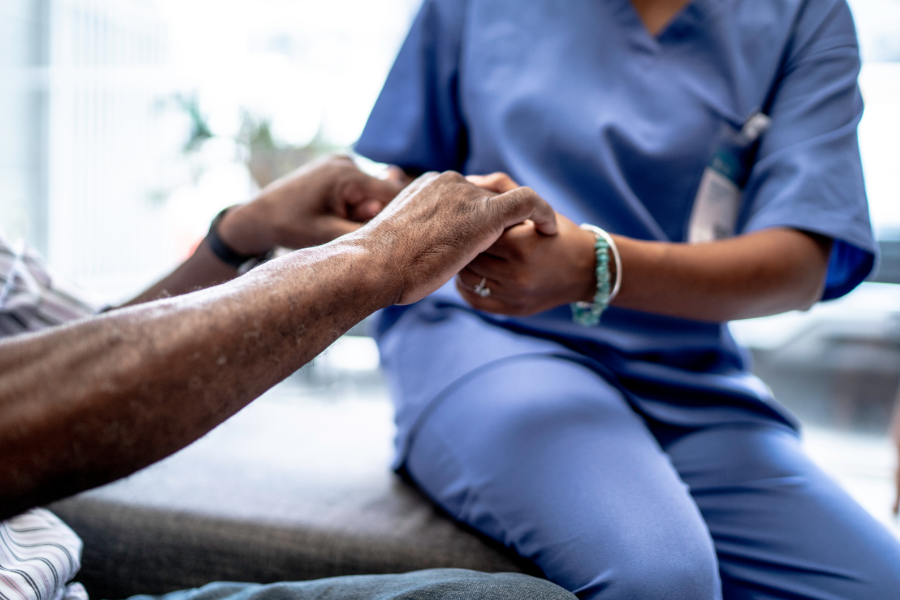- What is Medial Compartment Osteoarthritis?
- What Are The Symptoms Of Medial Compartmental Osteoarthritis?
- What Are The Causes And Risk Factors For Medial Compartment Osteoarthritis?
- Diagnosis of Medial Compartment Osteoarthritis
- What Is The Treatment For Medial Compartmental Osteoarthritis?
- Prevention of Medial Compartment Osteoarthritis
Do you suffer from knee pain or stiffness? Medial compartment arthritis is one of the major causes of knee pain.
Medial compartment arthritis is the most common type of knee osteoarthritis, accounting for 60-70% of all cases. Knee arthritis affects millions of Americans, causing discomfort, decreased mobility, and a lower quality of life. Potential causes of this condition range from underlying health problems to age-related wear and tear.
At Louisville Hip & Knee Institute, we understand the impact knee arthritis can have on your life. We’re here to provide you with expert information to help you better understand this condition and how to get treatment.
What is Medial Compartment Osteoarthritis?
 Medial compartment osteoarthritis is a form of knee arthritis characterized by the gradual deterioration of the protective cartilage covering the ends of bones in the knee joint. This degeneration leads to bone-on-bone friction within the medial compartment on the inner side of the knee.
Medial compartment osteoarthritis is a form of knee arthritis characterized by the gradual deterioration of the protective cartilage covering the ends of bones in the knee joint. This degeneration leads to bone-on-bone friction within the medial compartment on the inner side of the knee.
The knee comprises three compartments: the lateral compartment (outer side), the medial compartment (inner side), and the patellofemoral compartment (kneecap and part of the femur). While osteoarthritis can affect any of these compartments, it most commonly manifests in the medial compartment.
What Are The Symptoms Of Medial Compartmental Osteoarthritis?
Symptoms of medial compartmental OA resemble those of other knee osteoarthritis types, typically progressing gradually:
- Increasing pain, particularly during activity
- Morning stiffness
- Swelling or inflammation
- Joint “locking” after prolonged sitting
- Exacerbated symptoms following vigorous activity
- Knee instability
Over time, these symptoms can significantly impact your quality of life.
What Are The Causes And Risk Factors For Medial Compartment Osteoarthritis?
 The articular cartilage serves as a protective buffer between bones. When it deteriorates, osteoarthritis (OA) can develop.
The articular cartilage serves as a protective buffer between bones. When it deteriorates, osteoarthritis (OA) can develop.
In OA, the loss of cartilage causes bones to rub against each other during movement, triggering friction and inflammation. This can result in pain, further cartilage damage, and the formation of bone spurs within the joint.
Several factors increase the risk of developing OA, including a family history of the condition, advancing age, and obesity.
Medial compartmental OA may arise from various causes, such as:
- Traumatic injuries that harm the cartilage
- Knee misalignment
- Overuse of a misaligned or injured knee
- Meniscus injuries, which damage the fibrocartilage between the thighbone and shinbone
Diagnosis of Medial Compartment Osteoarthritis
In diagnosing medial compartmental OA, a healthcare provider typically:
- Conducts a physical examination
- Inquires about your medical history, including previous injuries
- Checks for any signs of misalignment
- Orders X-rays to assess damage to the knee joint or cartilage, aiding in determining the extent of OA involvement, whether it affects multiple compartments or solely the medial compartment
- Orders MRIs if necessary
Depending on the findings, your provider may refer you to a specialist in OA management, such as an orthopedic surgeon or rheumatologist.
What Is The Treatment for Medial Compartmental Osteoarthritis?
 Your doctor may recommend various approaches to managing osteoarthritis in your knees, such as:
Your doctor may recommend various approaches to managing osteoarthritis in your knees, such as:
- Medication: Nonsteroidal anti-inflammatory drugs (NSAIDs) can alleviate pain and swelling.
- Knee brace: Using a brace can help alleviate pressure on the inner part of your knee.
- Physical therapy: Tailored exercises can strengthen muscles and improve knee function.
- Ice and heat therapy: Alternating between ice and heat applications can relieve pain and inflammation.
- Surgical options: In certain cases, surgery may be recommended, including:
- Total knee replacement (total knee arthroplasty) involves replacing all or part of the knee joint, including bone and cartilage.
Unicompartmental knee arthroplasty: Only the medial side of the knee is replaced.
Prevention of Medial Compartment Osteoarthritis
While certain risk factors for medial compartment osteoarthritis, such as age and genetics, cannot be modified, there are steps you can take to reduce your risk and promote joint health:
- Maintain a healthy weight: Excess weight increases the load on your knee joints, accelerating cartilage degeneration. Adopting a balanced diet and regular exercise can help manage weight and reduce knee stress.
- Protect your knees: Avoid activities that strain the knee joints excessively, such as high-impact sports or repetitive movements. Use proper footwear and protective gear when engaging in physical activities to minimize the risk of injury.
- Stay active: Regular exercise can help strengthen the muscles surrounding the knee joint, improve joint stability, and enhance overall joint health. Incorporate low-impact activities like swimming, cycling, or walking into your routine to maintain joint function and mobility.
Adopting these preventive measures and seeking early medical intervention can reduce your risk of developing medial compartment osteoarthritis and help you enjoy optimal joint health for years.
Next Steps for Medical Compartment Osteoarthritis
If you are experiencing symptoms of medial compartment osteoarthritis, seeking treatment as soon as possible is important. Are you ready to take the next step towards healthier knees? Schedule an appointment today with the Louisville Hip & Knee Institute. We are here to provide the best care for your knees and help you get back to living your life to the fullest. Don’t let knee pain hold you back any longer.

